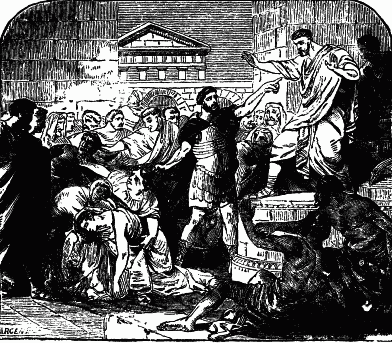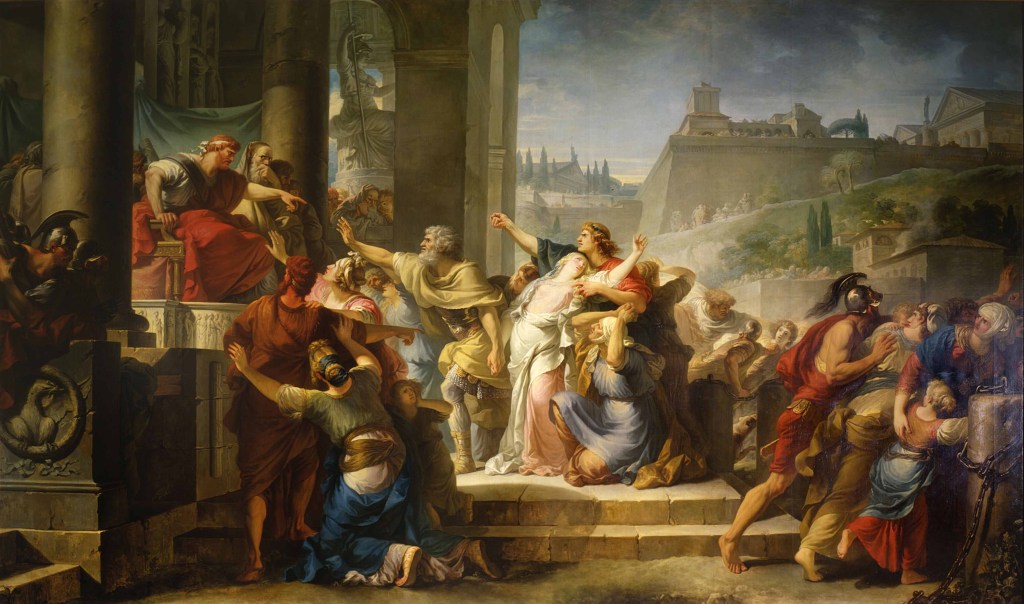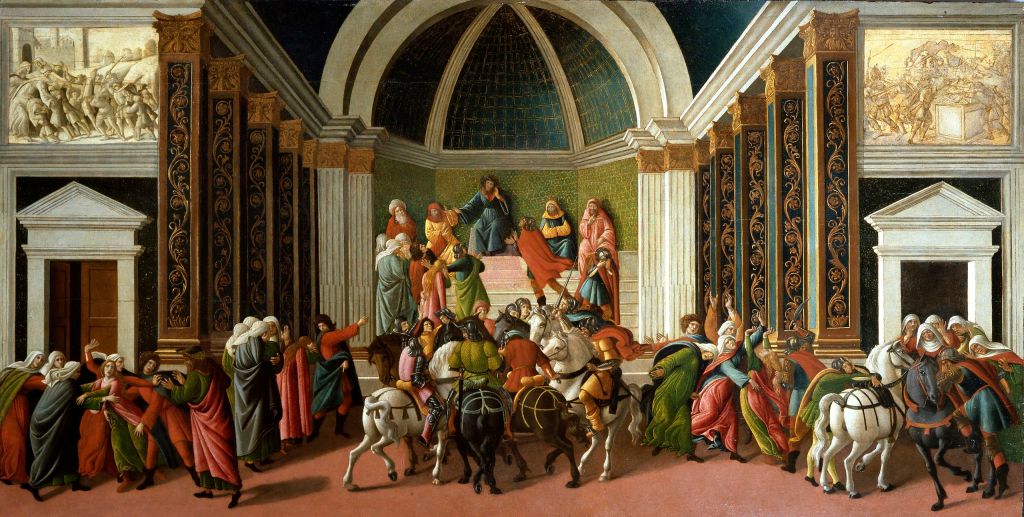ออฟไลน์ด้วยแอป Player FM !
Episode 115 – The Anatomy of a Murder
Manage episode 297531565 series 2782819
CW: The accounts of Virginia include paedophilic desire and violence against women.
Virginia has been murdered by her own father in the Forum in an attempt to protect her from the decemvir Appius Claudius. As far as Virginius and most other Roman dads are concerned, death is better than dishonour. What will this act mean for Virginius and his family? How will it impact Appius Claudius? Tune in to find out as we venture once more into the rule of the Second Decemvirate and deal with the aftermath of one of the crises of the Conflict of the Orders.
Looking to get up to sped on Verginia’s story so far – it begins here. Yes, you’re right, there’s a variety of ways to spell her name!
Episode 115 – The Anatomy of a Murder

Charlotte Mary Yong 1880. The Death of Verginia. Courtesy of Wikimedia Commons
Chaos in the City
Even though this is a key moment in the conflict between patricians and plebeians, there are still some intriguing differences in the accounts provided by Livy and Dionysius. In Dr Rad’s account, Verginius is quick to fight his way out of Rome in the midst of the chaos with a band of supporters, leaving Verginia’s fiancée Icilius and her uncle Numitorius to display the body of the murdered girl to the crowd.
In a scene very reminiscent of Lucretia’s body being used to incite the overthrow of the monarchy, Verginia’s corpse is used as a symbol of the corruption of the Second Decemvirate and the crowd starts to get dangerous. It seems that they may also have some allies – the disgruntled patricians who also despise the decemvirs. The leaders of this faction include Valerius and Horatius, and they are getting a lot of love from the citizens for standing up to Appius Claudius and his cronies.
Meanwhile, in Dionysius’ account, there is a lot more focus on the fate of Verginia’s body. When Appius tries to have her removed from the Forum, the people claim her body for their own and stage a funeral procession for the murdered girl. Livy and Dionysius clearly have included different details regarding the aftermath of her death, but in both accounts, she is clearly a symbol in life and death.
These stories highlight how women are used by male writers to draw attention to the virtues and vices of the men around them. In this sense, these histories were not striving for an analytical and objective account, but one that promoted a desirable ideology for their own time. It is very clear that these were histories designed to inspire those who read them to act in ways that would benefit the state and keep order.
A Real Cliffhanger
In spite of their differences, both Livy and Dionysius end up leading us to the same point. We switch from events in Rome to Verginius’ return to his army encampment. Covered in the blood of his daughter and still clutching the murder weapon, he makes a rousing speech in both accounts, trying to persuade his fellow-soldiers that the real criminal in this sordid affair is Appius Claudius. Will the soldiers support him in seeking vengeance against the decemvir? Or will the tyrannous rule of the ten continue?

Gabriel François Doyen c. 1757. La Mort de Virginie (The Death of Virginia)
Our Players
The Decemvirs
- Appius Claudius. Ap. f. M. n. Crassus Inregillensis Sabinus Pat – Cos. 471, 451
- Spurius Oppius Cornicen
- Quintus Fabius M. f. M. n. Vibulanus Pat – Cos. 467, 465, 459
- Quintus Poetelius Libo Visolus
- Manius Rabuleius
- Marcus Cornelius – f. Ser. n. Maluginenesis Pat
- Lucius Minucius P. f. M. n. Esquilinus Augurinus Pat – Cos. 458
- Marcus? Sergius Esquilinus Pat
- Titus Antonius Merenda
- Caeso Duillius Longus?
The Senators
- Lucius Valerius Potitus
- Marcus Horatius Barbatus
The Verginii and Supporters
- Verginia
- Verginius – father of Verginia
- Publius Numitorius – Verginia’s maternal uncle
- Lucius(?) Icilius – former tribune of the plebs and Verginia’s betrothed
Our Sources
- Dr Rad reads Livy, From the Founding of the City 3.48-50
- Dr G reads Dionysius of Halicarnassus, Roman Antiquities 11.37-40
- Joshel, S. 2002. ‘The Body Female and the Body Politic: Livy’s Lucretia and Verginia.’ In Sexuality and gender in the classical world: readings and sources, edited by Sandra R. Joshel & Laura K. McClure, 163-190. Oxford: Blackwell.
- Keegan, P. 2021. Livy’s Women: Crisis, Resolution, and the Female in Rome’s Foundation History. New York: Routledge.
Sound Credits
Additional music and sound in this episode includes an original composition for our podcast by the wonderful Bettina Joy de Guzman. Sound Effects courtesy of Audio Micro and Fesliyan Studios.

Sandro Botticelli c. 1496-1504. The Story of Virginia. Courtesy of Wikimedia Commons.
This painting presents the different phases of Virginia’s story in different parts of the painting. From left to right: Virgina is violated by Marcus Claudius while in the company of other women; Marcus Claudius takes her to the tribunal presided by Appius Claudius who declares her to a slave; The family of Virginia plead for justice; Verginius murders Virginia and then flees Rome on horseback.
160 ตอน
Manage episode 297531565 series 2782819
CW: The accounts of Virginia include paedophilic desire and violence against women.
Virginia has been murdered by her own father in the Forum in an attempt to protect her from the decemvir Appius Claudius. As far as Virginius and most other Roman dads are concerned, death is better than dishonour. What will this act mean for Virginius and his family? How will it impact Appius Claudius? Tune in to find out as we venture once more into the rule of the Second Decemvirate and deal with the aftermath of one of the crises of the Conflict of the Orders.
Looking to get up to sped on Verginia’s story so far – it begins here. Yes, you’re right, there’s a variety of ways to spell her name!
Episode 115 – The Anatomy of a Murder

Charlotte Mary Yong 1880. The Death of Verginia. Courtesy of Wikimedia Commons
Chaos in the City
Even though this is a key moment in the conflict between patricians and plebeians, there are still some intriguing differences in the accounts provided by Livy and Dionysius. In Dr Rad’s account, Verginius is quick to fight his way out of Rome in the midst of the chaos with a band of supporters, leaving Verginia’s fiancée Icilius and her uncle Numitorius to display the body of the murdered girl to the crowd.
In a scene very reminiscent of Lucretia’s body being used to incite the overthrow of the monarchy, Verginia’s corpse is used as a symbol of the corruption of the Second Decemvirate and the crowd starts to get dangerous. It seems that they may also have some allies – the disgruntled patricians who also despise the decemvirs. The leaders of this faction include Valerius and Horatius, and they are getting a lot of love from the citizens for standing up to Appius Claudius and his cronies.
Meanwhile, in Dionysius’ account, there is a lot more focus on the fate of Verginia’s body. When Appius tries to have her removed from the Forum, the people claim her body for their own and stage a funeral procession for the murdered girl. Livy and Dionysius clearly have included different details regarding the aftermath of her death, but in both accounts, she is clearly a symbol in life and death.
These stories highlight how women are used by male writers to draw attention to the virtues and vices of the men around them. In this sense, these histories were not striving for an analytical and objective account, but one that promoted a desirable ideology for their own time. It is very clear that these were histories designed to inspire those who read them to act in ways that would benefit the state and keep order.
A Real Cliffhanger
In spite of their differences, both Livy and Dionysius end up leading us to the same point. We switch from events in Rome to Verginius’ return to his army encampment. Covered in the blood of his daughter and still clutching the murder weapon, he makes a rousing speech in both accounts, trying to persuade his fellow-soldiers that the real criminal in this sordid affair is Appius Claudius. Will the soldiers support him in seeking vengeance against the decemvir? Or will the tyrannous rule of the ten continue?

Gabriel François Doyen c. 1757. La Mort de Virginie (The Death of Virginia)
Our Players
The Decemvirs
- Appius Claudius. Ap. f. M. n. Crassus Inregillensis Sabinus Pat – Cos. 471, 451
- Spurius Oppius Cornicen
- Quintus Fabius M. f. M. n. Vibulanus Pat – Cos. 467, 465, 459
- Quintus Poetelius Libo Visolus
- Manius Rabuleius
- Marcus Cornelius – f. Ser. n. Maluginenesis Pat
- Lucius Minucius P. f. M. n. Esquilinus Augurinus Pat – Cos. 458
- Marcus? Sergius Esquilinus Pat
- Titus Antonius Merenda
- Caeso Duillius Longus?
The Senators
- Lucius Valerius Potitus
- Marcus Horatius Barbatus
The Verginii and Supporters
- Verginia
- Verginius – father of Verginia
- Publius Numitorius – Verginia’s maternal uncle
- Lucius(?) Icilius – former tribune of the plebs and Verginia’s betrothed
Our Sources
- Dr Rad reads Livy, From the Founding of the City 3.48-50
- Dr G reads Dionysius of Halicarnassus, Roman Antiquities 11.37-40
- Joshel, S. 2002. ‘The Body Female and the Body Politic: Livy’s Lucretia and Verginia.’ In Sexuality and gender in the classical world: readings and sources, edited by Sandra R. Joshel & Laura K. McClure, 163-190. Oxford: Blackwell.
- Keegan, P. 2021. Livy’s Women: Crisis, Resolution, and the Female in Rome’s Foundation History. New York: Routledge.
Sound Credits
Additional music and sound in this episode includes an original composition for our podcast by the wonderful Bettina Joy de Guzman. Sound Effects courtesy of Audio Micro and Fesliyan Studios.

Sandro Botticelli c. 1496-1504. The Story of Virginia. Courtesy of Wikimedia Commons.
This painting presents the different phases of Virginia’s story in different parts of the painting. From left to right: Virgina is violated by Marcus Claudius while in the company of other women; Marcus Claudius takes her to the tribunal presided by Appius Claudius who declares her to a slave; The family of Virginia plead for justice; Verginius murders Virginia and then flees Rome on horseback.
160 ตอน
ทุกตอน
×ขอต้อนรับสู่ Player FM!
Player FM กำลังหาเว็บ




